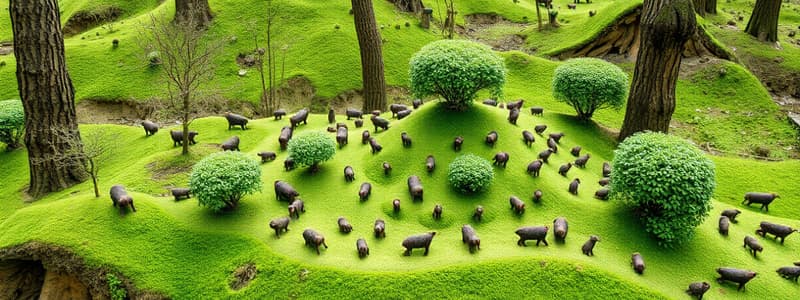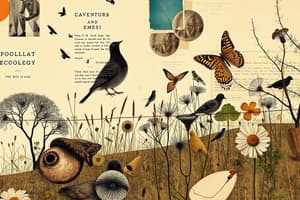Podcast
Questions and Answers
Which of the following factors is NOT a key feature of a population?
Which of the following factors is NOT a key feature of a population?
- Density
- Size
- Range
- Biodiversity (correct)
An ecosystem includes only the living (biotic) components of an area.
An ecosystem includes only the living (biotic) components of an area.
False (B)
What is a primary difference between exponential and logistic growth models?
What is a primary difference between exponential and logistic growth models?
- Exponential growth considers carrying capacity, while logistic growth does not.
- Exponential growth applies to populations approaching their carrying capacity, while logistic growth does not.
- Logistic growth considers carrying capacity, while exponential growth does not. (correct)
- Logistic growth uses biotic potential, while exponential growth does not.
Species that maximize reproductive success in uncrowded environments are known as ______ strategists.
Species that maximize reproductive success in uncrowded environments are known as ______ strategists.
Which of the following traits is typically associated with K-strategist species?
Which of the following traits is typically associated with K-strategist species?
Name two factors that can cause a population to decrease.
Name two factors that can cause a population to decrease.
What are the products of photosynthesis?
What are the products of photosynthesis?
Match the trophic level with the type of organism:
Match the trophic level with the type of organism:
Which of the following best describes the carbon source for chemoautotrophs?
Which of the following best describes the carbon source for chemoautotrophs?
Which population demographic applies to a country that has rapid population growth?
Which population demographic applies to a country that has rapid population growth?
Flashcards
What is a population?
What is a population?
A group of individuals of the same species occupying the same environment
What is an ecosystem?
What is an ecosystem?
All living (biotic) and non-living (abiotic) components in an area
What is an exponential growth model?
What is an exponential growth model?
A model that applies to populations without growth limits, using biotic potential.
What is an r-strategist?
What is an r-strategist?
Signup and view all the flashcards
What is a K-strategist?
What is a K-strategist?
Signup and view all the flashcards
Factors that cause a population to decrease?
Factors that cause a population to decrease?
Signup and view all the flashcards
What is the purpose of Photosynthesis?
What is the purpose of Photosynthesis?
Signup and view all the flashcards
Name the trophic Levels in a food web
Name the trophic Levels in a food web
Signup and view all the flashcards
Energy and carbon sources for Photoautotroph?
Energy and carbon sources for Photoautotroph?
Signup and view all the flashcards
What are Endemic species?
What are Endemic species?
Signup and view all the flashcards
Study Notes
Population Ecology
- Population is a group of individuals of the same species occupying the same environment
- Three key population features include size, range, and density
- A community comprises different species living together, interacting through predation, competition, and symbiosis
- An ecosystem encompasses all biotic (living) and abiotic (non-living) components in an area
Exponential and Logistic Growth Models
- Exponential growth models apply to populations with no growth limits, utilizing biotic potential
- Logistic growth models apply to populations approaching their carrying capacity
- Exponential growth lacks carrying capacity, allowing unconstrained population growth
- Logistic growth allows population growth until it reaches its maximum, where the growth rate slows
r and K Strategists
- r-strategy species traits maximize reproductive success in uncrowded environments
- K-strategy species traits maximize fitness in crowded environments
- R-strategists have a type 3 survivorship curve, early reproduction, many offspring, short life span, little parental care, one reproduction event, and small adult size; they are prey below carrying capacity
- K-strategists have type 1 and 2 survivorship curves, late reproduction, few offspring, long life span, much parental care, multiple reproductions, and large adult size; they are predators near carrying capacity
Factors Causing Population Decrease
- Changes to birth and death rates decrease population
- High death rate or low birthrate
- Limited resources like food, water, and shelter
- Climate change, such as rising temperatures
- Disease/epidemics, such as white-nose syndrome in bats
Photosynthesis Purpose and Products
- Photosynthesis converts light energy into chemical energy, powering life with the sun's rays
- The products of photosynthesis are glucose and oxygen
Importance of Photosynthesis
- Photosynthesis makes food and adds oxygen to the atmosphere
Food Chains/Webs and Trophic Levels
- 1st level: producers (plants, algae, grass) make their own food through photosynthesis or chemosynthesis; they are the foundation of the food web
- 2nd level: primary consumers (grasshoppers, bees, ants, butterflies) are herbivores that eat producers
- 3rd level: secondary consumers (rats, sparrows, frogs) are carnivores or omnivores eating primary consumers
- 4th level: tertiary consumers (snakes, owls) are carnivores eating secondary consumers; they are top predators with few natural predators
- Decomposers (fungi, bacteria) and detritivores (earthworms, scavengers) are also important, but not trophic levels
- 90% of energy is lost as it passes through the trophic levels
Metabolic Categories
- Photoautotrophs: use light energy with carbon dioxide as the carbon source (e.g., cyanobacteria, plants, algae)
- Photoheterotrophs: use light energy with organic compounds as the carbon source (e.g., purple nonsulfur bacteria)
- Chemoautotrophs: use inorganic compounds (NH3 & H2S) as the energy source and CO2 as the carbon source (e.g., purple sulfur bacteria)
- Chemoheterotrophs: use organic compounds for both energy and carbon (e.g., fungi, animals, most bacteria)
Human Population Growth
- Reduced death rate, public health changes, infectious disease impacts, and technological advances have contributed to human population growth
- Rapid growth occurs in countries with pyramid-shaped age structure diagrams and young demographics
- Stable populations have dome-shaped age structures with even distribution across age groups
- Declining populations have inverted pyramid-shaped structures with more elderly
Biomes
- Tropical rainforests have stable temps (20-34°C), yearlong growing season, high rainfall (50-200 inches), high biodiversity, and productivity
- Savannas are tropical/subtropical grasslands with moderate, seasonal rainfall, transitional between forests and deserts with widely spaced trees and seasonal migrations
- Chaparral (scrub forest) has annual rainfall (25.6-29.5 inches), mostly in winter; vegetation is dominated by shrubs adapted to periodic fires
- Deserts have unpredictable, little precipitation, temps fluctuate (60°C day, 0°C night); vegetation is sparse and adapted for water conservation
Biomes Part 2
- Temperate Grasslands (prairies/steppes) have seasonal temps, less precipitation than savannas, deep fertile soil, seasonal migration, and fires
- Temperate forests have mild, seasonal climates with plentiful rain (29.5-59 in), soil rich in organic material, and deciduous trees; biodiversity is diminished by human activity
- Taiga (Boreal Forest) has harsh winters, cold/dry winters, short/cool/wet summers; evergreen trees are adapted for the cold, with limited precipitation, mostly in winter
- Tundra is above the taiga, below the poles, with low precipitation, open windswept areas, permafrost, and low species richness
Aquatic Biomes
- Freshwater covers only 2% of Earth, provides drinking water, crop irrigation, sanitation, and habitat
- Marine (salt water) is influenced by light levels, temps, tides, and currents; primary producers are phytoplankton and rooted plants in photic zones; 3 ocean ecosystems: open ocean, continental shelves, deep sea
Community Ecology
- Ecological niche is the total ways a species uses resources and impacts its environment, including space, food, abiotic parameters, mating conditions, and ecosystem role
Ecological Succession
- Succession produces a change in species composition over time
- Primary succession begins with a barren, lifeless substrate
- Secondary succession is in an existing community that has been disturbed
Competitive Exclusion
- Competitive exclusion: The species better able to utilize a shared niche will eliminate the other (survival of the fittest)
- Resource partitioning: Is the division of niches that allow for coexistence. Temporal, morphological, and spatial.
Symbiosis Types
- Mutualism benefits both species
- Antagonism is where one or both parties lose more than they gain and is classified as competition, predation or parasitism
- Commensalism benefits one species and is neutral to the other
Example Predation and Adaptations
- Monarch butterflies consume milkweed and as a result, the monarch butterflies themselves are toxic to birds
Biodiversity
- Bacteria: prokaryotic; cells lack organelles, single-celled, found in all ecosystems
- Archaea: prokaryotic; are extremophiles
- Eukarya: multicellular or single-celled, have a nucleus
- Protists: not fungus, plant, or animal; usually single-celled
- Fungi: multicellular or single-celled; heterotrophic
- Plants: multicellular; photoautotrophs; perform photosynthesis
- Animals: multicellular; heterotrophic
Endemic Species
- Endemic species are found in only one geographical area
- Disruption of ecosystem interactions, pollution and loss of genetic variation can impact biodiversity loss
- Solutions to biodiversity loss include changing human behavior, habitat conservation and restoration
Example of Natural Selection
- Galapagos finches have beak size variations, some finches have long, strong beaks and others had smaller, more delicate beaks
- The weather and environment, determines which finches will be more suitable
- Over generations, finches with beak size that were suitable for the climate would survive and reproduce with the same trait
Studying That Suits You
Use AI to generate personalized quizzes and flashcards to suit your learning preferences.




